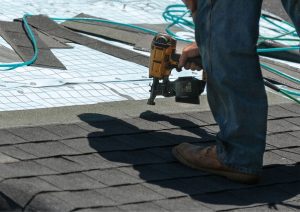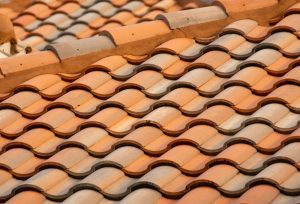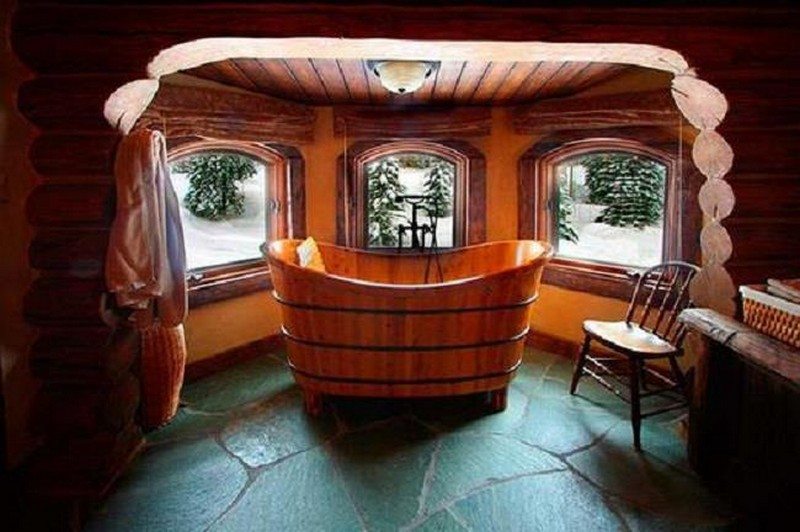
Timber baths and basins embody an elegant fusion of tradition and modern luxury, bringing a piece of nature into the heart of your home. Apart from their exquisite appearance, these fittings give any bathroom design a feeling of coziness and warmth. Timber bathtubs and basins, made of different woods, each with distinctive grains and natural colors, provide an organic look that is impossible to match with synthetic materials.
Beyond just their aesthetic appeal, ecologically concerned customers often choose these timber components because of their sustainability and eco-friendliness. Whether you’re renovating a bathroom or building a new home, incorporating timber baths and basins can transform your space into a tranquil sanctuary that invites relaxation and tranquility. This article explores the historical significance, benefits, and maintenance tips for timber baths and basins, providing you with comprehensive insights to make an informed decision about this timeless bathroom feature.

Timber Baths and Basins Basics
Historical Significance and Modern Resurgence of Timber Baths and Basins
Timber has been a cherished material in the construction of baths and basins for centuries, deeply embedded in many cultures around the world. Historically, wood was one of the earliest materials used for these purposes, evident from traditional Japanese ofuro tubs to the ornate wooden bathtubs of Victorian Europe. These wooden baths were not only functional but also symbols of craftsmanship and natural beauty. In Japan, the use of fragrant hinoki wood, revered for its durability and pleasant scent, exemplifies the cultural importance of wood in daily rituals of wellness and relaxation.
In Scandinavia and the Baltic regions, wooden bathtubs and saunas have been central to local bathing traditions, valued for wood’s natural properties that promote warmth and insulation. These practices highlight a global appreciation for wood, transcending purely aesthetic values to embrace the sensory and therapeutic benefits it offers.
In eastern cultures, however, one thoroughly cleanses oneself before entering timber baths and basins. In fact, the bath is used for soaking and relaxing, not for cleansing. For that reason, Japanese baths are typically shared by the entire family, sometimes communally and other times serially.
Water is and will increasingly be, a scarce resource. A typical bath requires between 250 L and 300 L of water to fully immerse a body. If a family of four all take a fresh bath, 1000 L of water has just been consumed.
A Japanese family of four would consume only 250 L of water plus a small amount for cleansing before entering the bath. The water needs to be heated so the western family is not only using four times the water, they are consuming four times the energy to heat that water.
Decline and Reasons
Despite its rich history, the popularity of timber in bath and basin manufacturing saw a decline with the advent of modern materials like acrylic, ceramic, and cast iron. These materials offered ease of mass production, reduced costs, and increased durability when exposed to the harsh chemicals commonly used in cleansing agents. As lifestyles modernized and maintenance times became a concern, the move towards more “convenient” materials seemed inevitable.
Modern Resurgence
However, the 21st century has witnessed a renewed interest in timber baths and basins. This resurgence is driven by several factors:
- Sustainability: As environmental concerns become more central to consumer choices, timber is increasingly valued for its sustainability, particularly when sourced responsibly. Wooden baths and basins are seen as eco-friendly alternatives to their plastic and metal counterparts.
- Artisanal Craftsmanship: There is a growing appreciation for the artisanal quality of handcrafted items. Timber baths are custom-made and can be tailored to individual preferences, which appeals to consumers looking for unique, bespoke home features.
- Thermal Properties: Wood’s natural ability to retain heat is a significant advantage, providing a longer, more energy-efficient soak compared to other materials. This quality, combined with the aesthetic and tactile warmth of wood, makes timber baths a luxury statement in modern bathrooms.
- Health and Wellness: With an increasing focus on wellness, the therapeutic qualities of wood, such as its natural oils and aromas, are celebrated for their stress-reducing properties. The use of wood in baths and basins supports a holistic approach to wellness at home, aligning with the spa-like experiences many seek in their personal spaces.
- Design Trends: The move towards natural materials in interior design has boosted the popularity of timber. Wood brings a touch of nature indoors, creating a serene and inviting bathroom environment. Its versatility in style adapts from rustic to contemporary, fitting various design aesthetics.
The modern resurgence of timber baths and basins reflects a blend of nostalgia for traditional craftsmanship and a push towards sustainable, health-oriented living. As more consumers recognize the unique benefits and sustainable attributes of timber, its role in bathroom design continues to evolve, marrying the old with the new in both function and form.
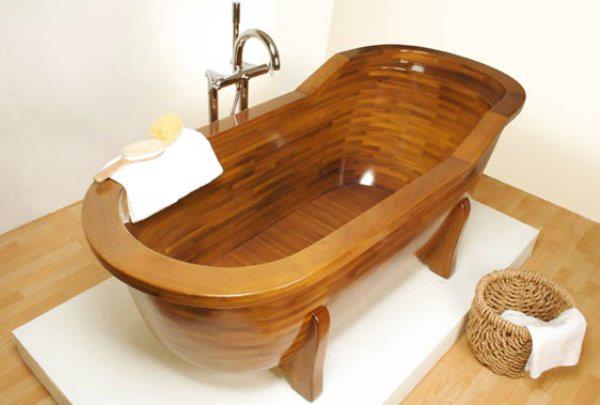
Benefits of Timber Baths and Basins
Timber baths and basins offer a unique blend of aesthetic appeal, durability, and eco-friendliness, making them a desirable choice for modern homes. These fixtures not only elevate the style of any bathroom but also provide functional advantages that make them a worthwhile investment.
Here, we explore the key benefits that make timber baths and basins a popular choice among homeowners and designers alike.
Natural Insulation and Heat Retention
One of the most significant benefits of timber baths and basins is their natural ability to retain heat. Wood acts as a natural insulator, keeping bath water warm for longer periods compared to materials like acrylic or metal. This property allows for a more relaxing, prolonged bathing experience without the need for frequent reheating of water, which can also lead to energy savings.
Aesthetic and Customizable Design
Timber baths and basins are renowned for their beauty and the warm ambiance they bring to a bathroom. The natural patterns and colors of wood add a touch of organic elegance that is difficult to replicate with synthetic materials. Moreover, wood can be easily shaped, stained, or carved, offering extensive customization options. Whether you desire a rustic, traditional look or a sleek, modern design, timber baths and basins can be crafted to meet specific aesthetic preferences.
Eco-Friendly Choice
Selecting wood sinks and bathtubs is a move in the direction of sustainable living. When ethically obtained, wood has a far smaller environmental effect than many other materials used in the production of bath and sinks. Wood is a renewable resource. Furthermore, compared to synthetic alternatives, wood decomposes naturally and does not create as many landfill problems at the end of its useful life.
Durability and Longevity
Timber baths and basins are exceptionally robust and may survive for many years when well cared for. Specially resistant to moisture, decay, and fungal growth—all of which are major worries in humid bathroom settings—are hardwoods like teak, cedar, and hinoki. Strong and long-lasting, these woods guarantee that the bath will be a focal point in the bathroom for many years to come.
Health and Wellness Benefits
Timber baths and basins contribute to a healthier home environment by incorporating natural materials that do not emit harmful chemicals. Wood inherently has hypoallergenic properties, making it suitable for those with allergies or sensitivities. Additionally, the natural textures and scents of wood can have a calming effect, enhancing the relaxation experience during bath time.
In summary, timber baths and basins are more than just visually appealing; they are a practical investment in your home’s comfort and sustainability. Their ability to retain heat, coupled with their customizable design, durability, eco-friendliness, and health benefits, makes timber baths and basins an excellent choice for any bathroom renovation or upgrade.
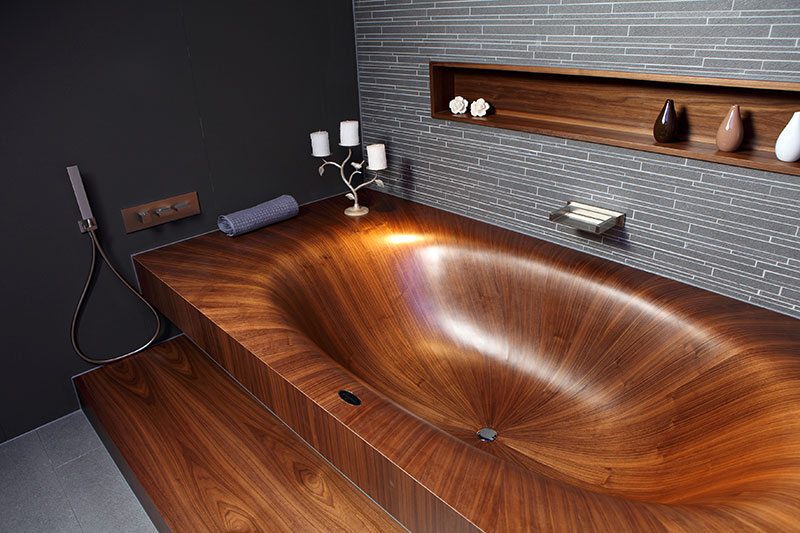
Care and Maintenance Tips
Timber baths and basins bring a unique aesthetic and warmth to any bathroom, but they also require specific care to maintain their beauty and functionality over time. Proper maintenance ensures that these natural fixtures remain durable and continue to enhance your bathroom’s ambiance.
Here are essential tips to help you take care of your timber baths and basins effectively.
Regular Cleaning
Keeping timber baths and basins clean is crucial for maintaining their appearance and longevity. Use a soft cloth or sponge to wipe the surface gently after each use. Avoid abrasive cleaners and harsh chemicals that can damage the wood’s finish. Instead, opt for mild soap and water or a cleaner specifically designed for wood. This will prevent the buildup of soap scum and minerals, keeping the surface looking fresh and clean.
Moisture Management
Managing moisture is key to preserving the integrity of timber baths and basins. Although wood is treated to withstand bathroom humidity, excessive water exposure can still cause damage over time. After use, make sure to dry off any standing water with a soft towel. This practice helps prevent watermarks and prolongs the finish of the wood.
Periodic Re-Sealing
Timber baths and basins are often sealed with a protective coating that repels water and prevents staining. Over time, this coating can wear down, so it’s important to re-seal the wood periodically. Check the manufacturer’s recommendations for the frequency of re-sealing. Typically, applying a fresh coat of sealant every one to two years will help maintain the wood’s resistance to water and keep it looking new.
Avoid Direct Heat and Sunlight
Exposure to direct heat and sunlight can cause timber baths and basins to warp, crack, or fade. It’s advisable to install these fixtures away from direct sunlight and to avoid placing hot items directly on the wood. If your bathroom gets a lot of natural light, consider using blinds or curtains to minimize sun exposure during peak hours.
By following these care and maintenance tips, your timber baths and basins can remain a stunning feature in your home for many years. Regular cleaning, moisture management, periodic re-sealing, and protection from direct heat are all critical to preserving the natural beauty and function of these elegant bathroom fixtures.
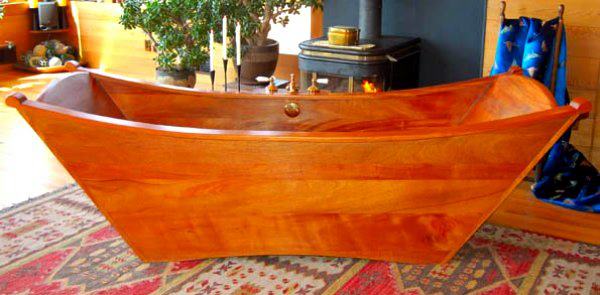
Selecting the timber
The best protection for your timber baths and basins comes from selecting the right timbers for the bath. Some timbers are denser, harder, or have a much higher oil content than others. A teak or ipe tub will have a natural resistance to water because of the high oil content in the timber.
Timbers such as these, absorb much less moisture and are more resistant to rot. The downside is that they are much harder to work and accordingly, will be considerably more expensive.
The very best quality Japanese tubs, ofuro, are made from a cypress called hinoki. It’s considered sacred and is used in the construction of palaces, temples, and shrines.
It is renowned for its beauty, strength, and durability. It grows only in Japan and accordingly, it is very expensive. A Hinoki tub imported into Australia or the USA will cost in the vicinity of $10,000.
At the other extreme is pine. It is readily available, cheap, and easy to work but will have a more limited life span due to the softness and the low-density nature of the timber. It easily absorbs moisture, which leads to swelling, shrinking, and cracking at a much faster and higher rate than a quality timber like ipe, hinoki, or teak.
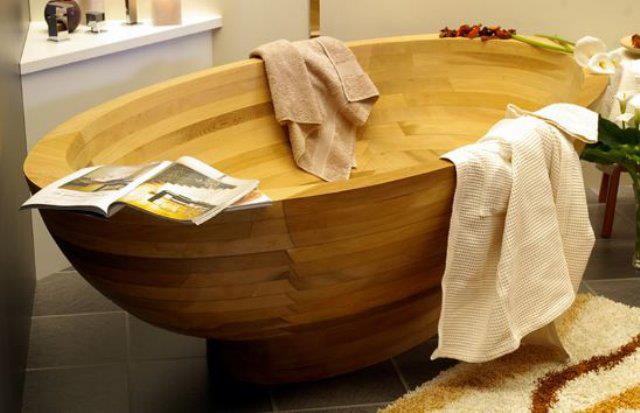
If timber baths are made from low-oil timber, the manufacturer will normally recommend that the timber baths be used at least once per week to stop them from drying out.
In other words, a certain level of moisture content is necessary for baths of that type. Of course, assuming that you enjoy taking baths, that would be a pro rather than a con!
If you are heading away from home for more than a week, these timber baths require that you place a bowl of water in the tub. The bowl should have a sponge in it that has at least 25% of the sponge exposed to air as an aid to evaporation.
The timber baths then need to be covered with a non-permeable cover. This ensures high humidity inside the timber baths so that the timber doesn’t dry out.
An excellent compromise is a cedar, which although softwood, has a high oil content, repels water, and is naturally resistant to decay.
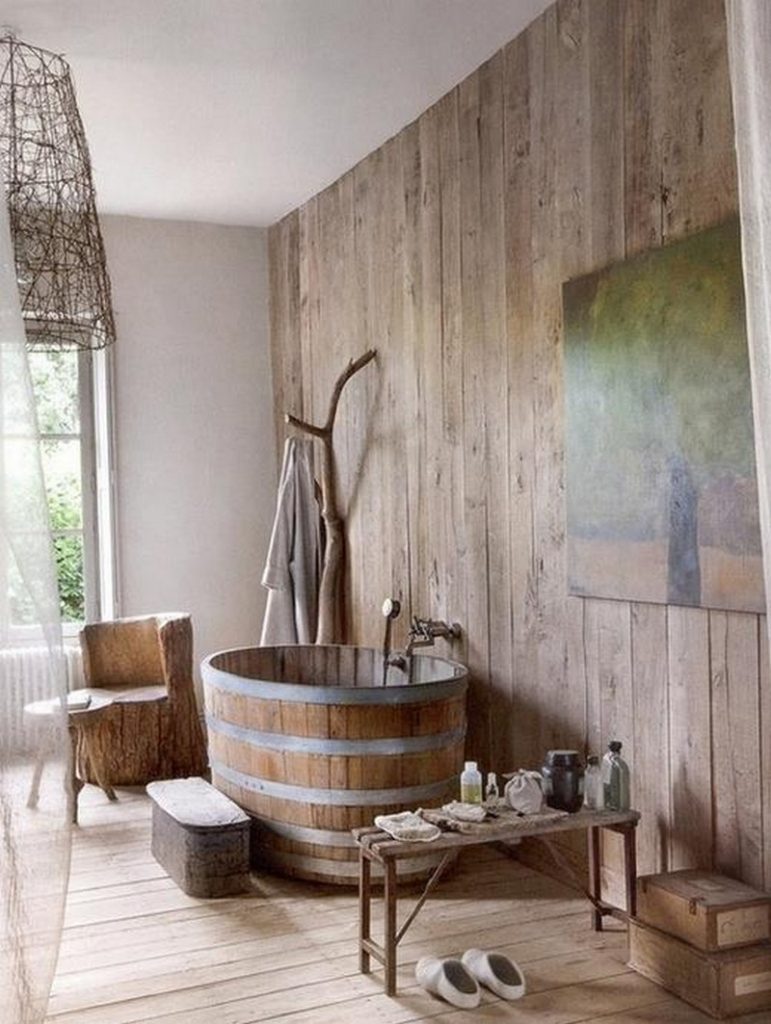
The traditional Chinese and Korean baths are usually made from cedar. As mentioned above, hinoki is the preferred timber in Japan, however, because of the cost, cedar is a popular alternative. A cedar tub made in Japan will typically cost around $4,000 – $5,000 landed in Australia or the USA.
Chinese-made cedar tubs, similar to the one shown below, can be purchased FOB for as little $500. Add freight and associated import costs and these still represent a bargain.
Most are handmade by small specialist manufacturers in China, such as Kangxi. Customization is therefore easy. In fact, even ‘one-off’ designs can be accommodated.

Maintenance of Timber Baths
Most new timber baths are treated by the manufacturer with multiple coats of sealer. Some are given clear coats of fiberglass. If the tub is sealed in this way, a simple abrasion-free cleaner is all that is required.
If the timber baths are sealed with oil, a wipe-down with vinegar will normally suffice. Of course, oiled surfaces can be easily and quickly refreshed according to the manufacturer’s instructions. But all manufacturers of wooden tubs recommend that their products be used for soaking, not cleansing.
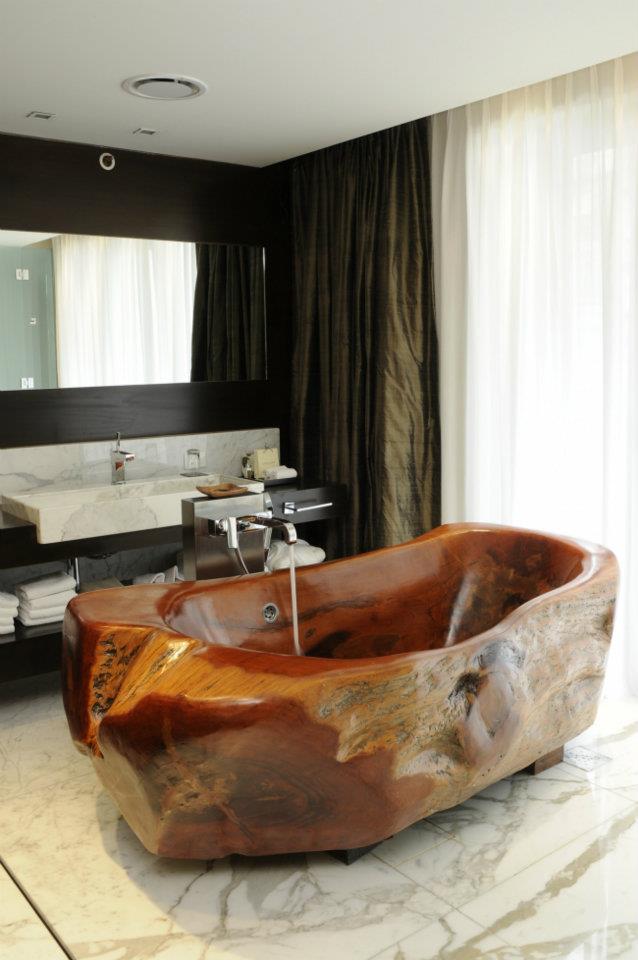
Look at Veneer Baths
A hybrid timber bath is one made from timber veneers, saturated in resin, and then compressed and shaped under very high pressure. The result is a bath that is as maintenance-free as a standard acrylic bath with the warm beauty of timber. Because veneers are used rather than solid timber, contours can be formed into the tub giving very fluid lines.
Timber baths and basins will require a little more work than a cast-iron or acrylic equivalent but will reward you for many years with its beautiful appearance. But if you intend to use the tub for cleaning, we suggest you stick with a nice acrylic tub and use timber accents to create a similar ambiance to a traditional ofuro.
We are absolutely knocked out by some of these. Which one is your favorite, or does a more standard bath better suit your personality?
Tell us what you think by commenting as you go through the images. 🙂
Click on any image to start the lightbox display. Use your Esc key to close the lightbox. You can also view the images as a slideshow if you prefer



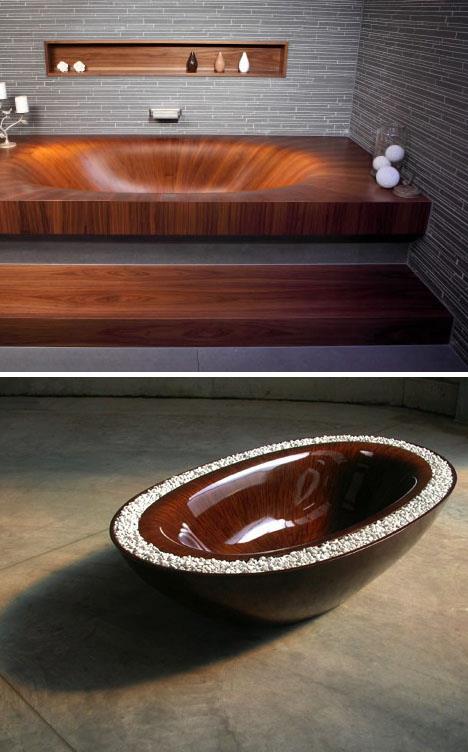
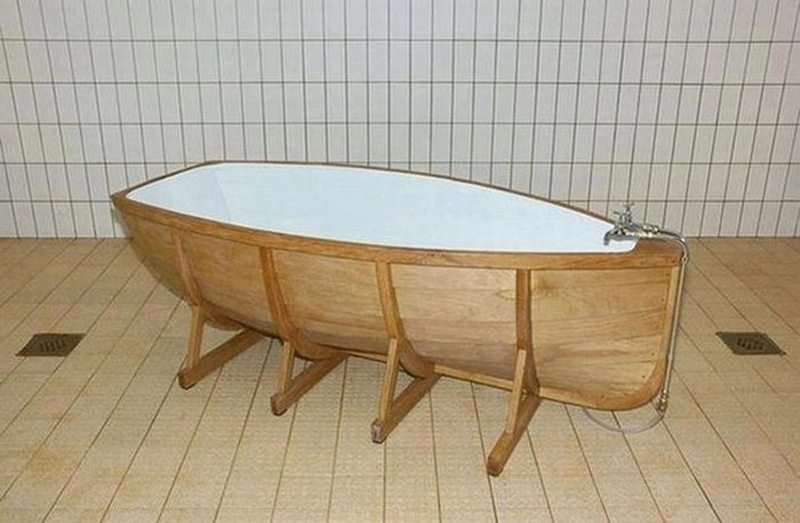


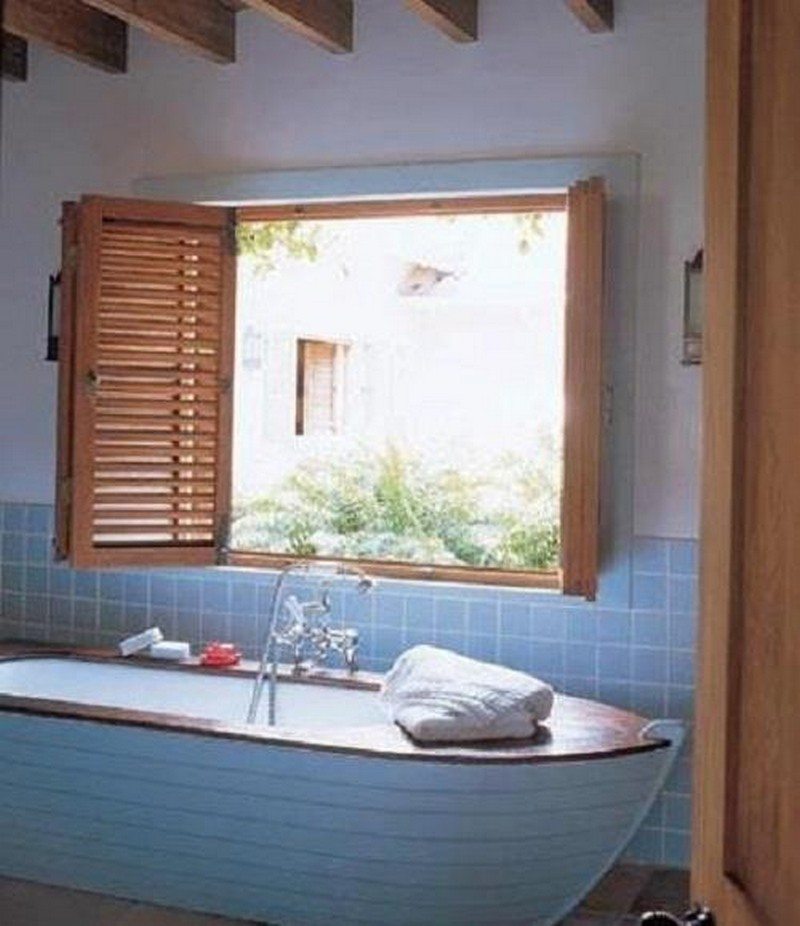
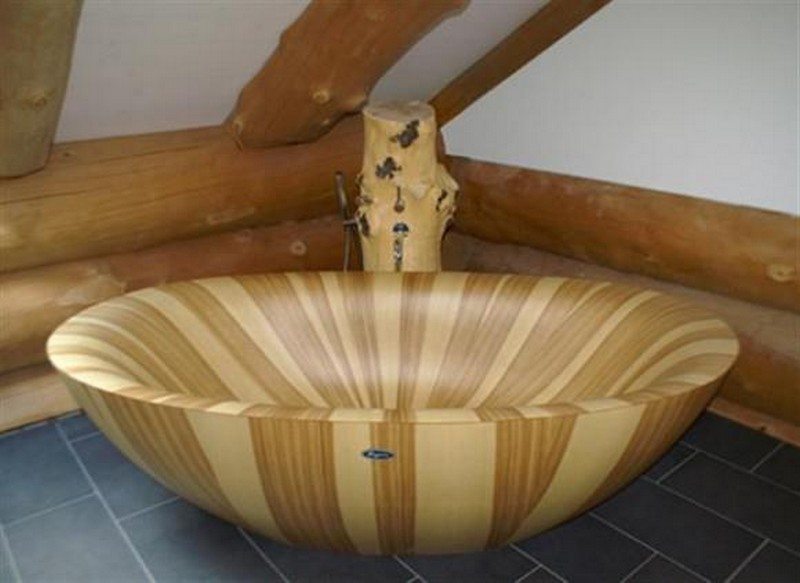
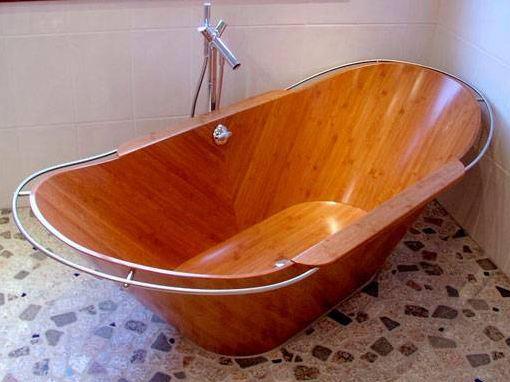
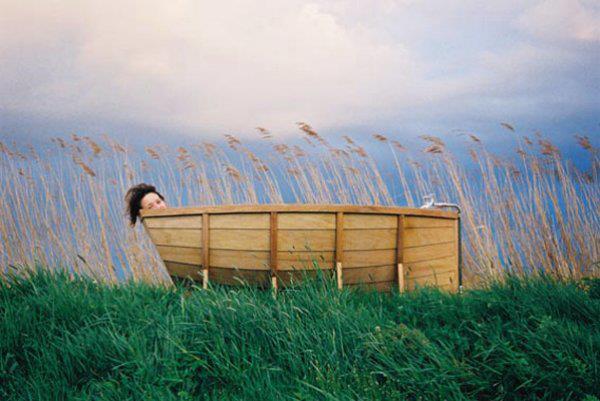



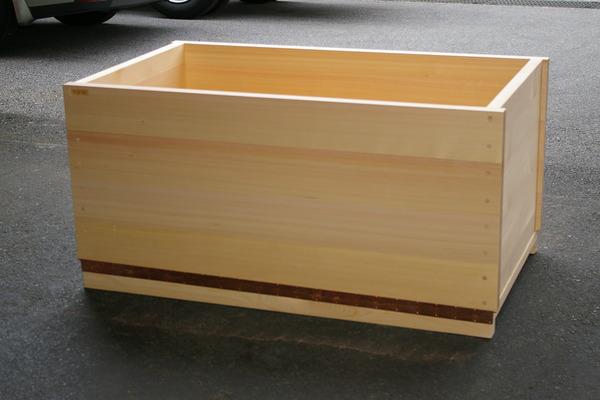
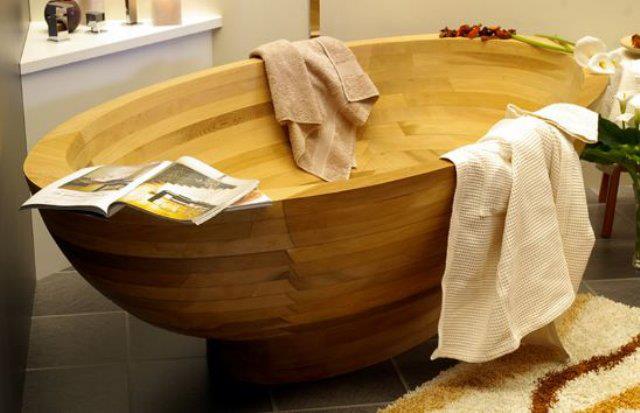
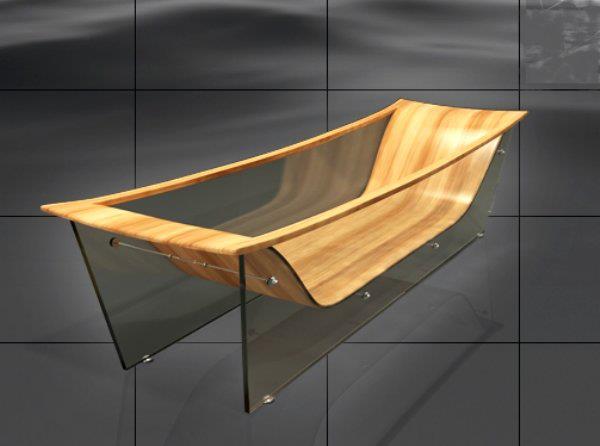
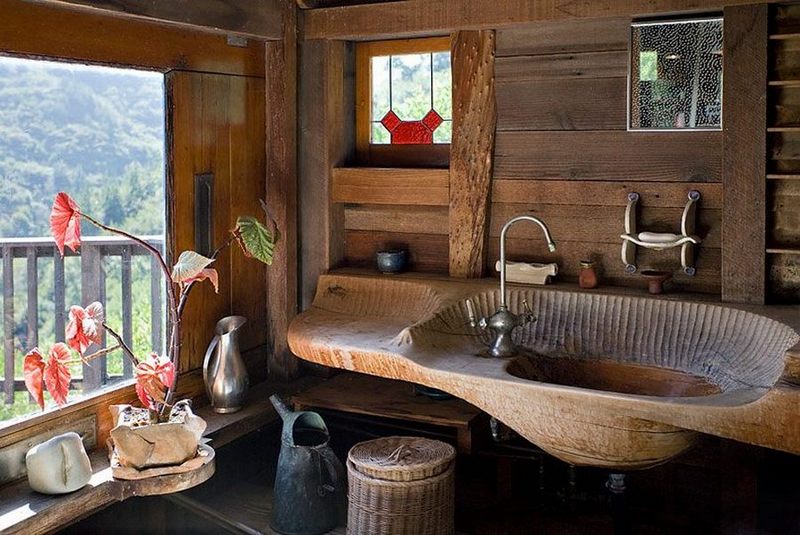
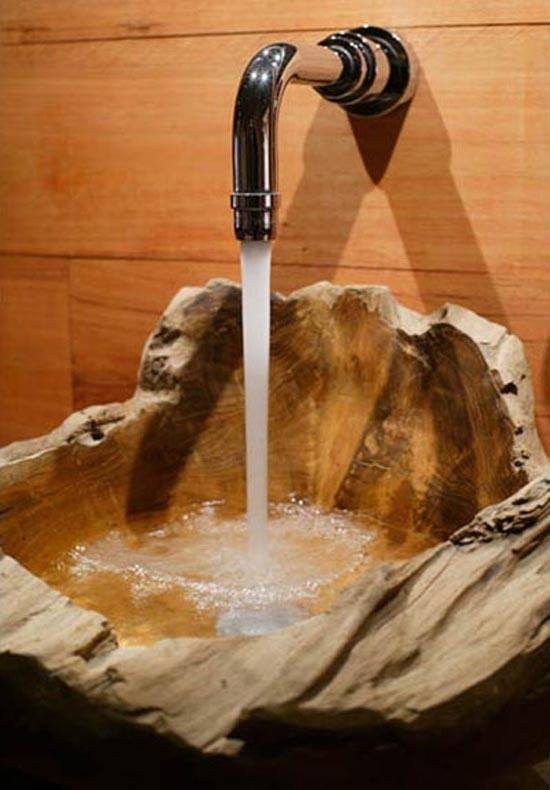
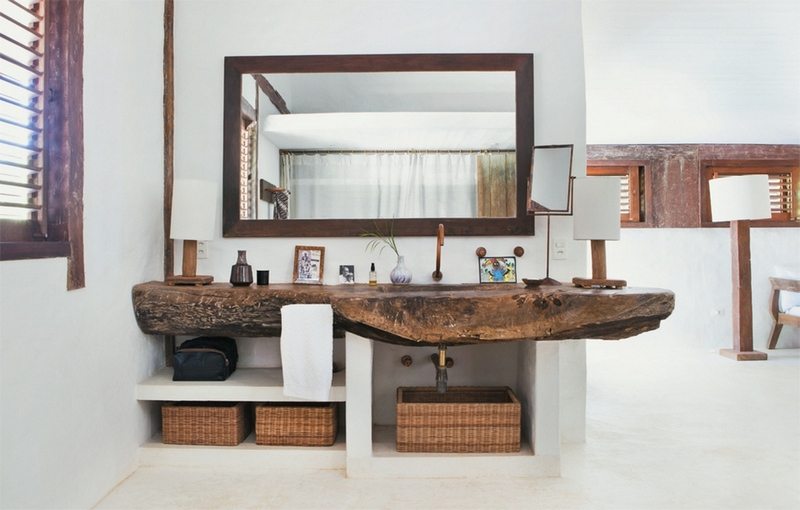
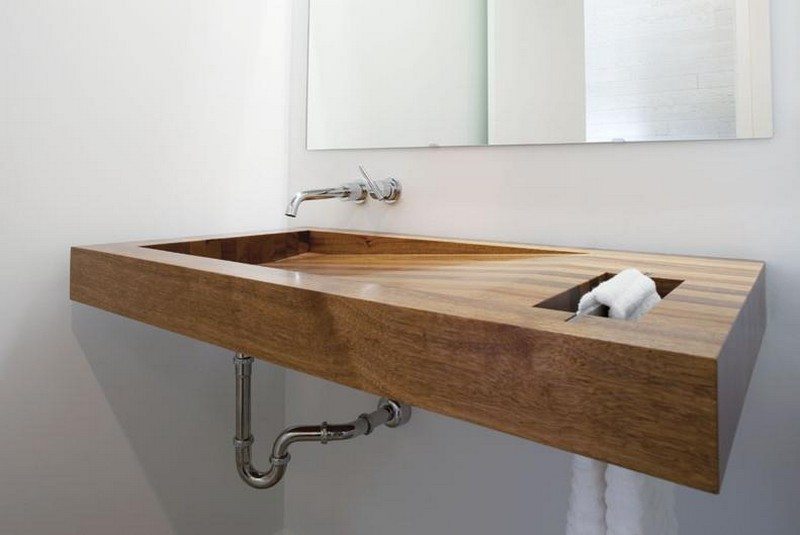
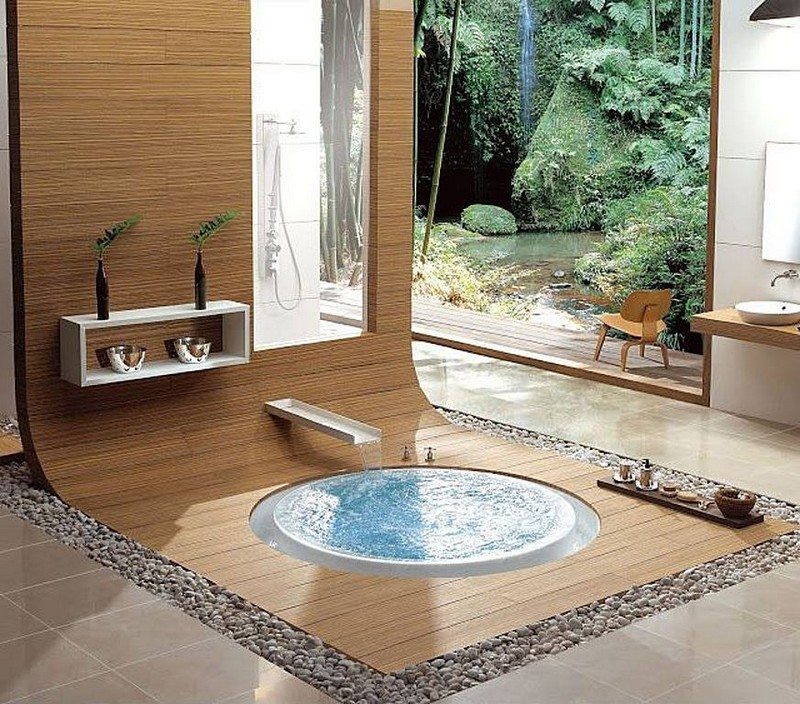
Conclusion
Timber baths and basins offer a unique combination of natural beauty, warmth, and sustainability that enhances any bathroom space. They require specific care and maintenance but reward homeowners with durability and a timeless aesthetic. As eco-friendly choices gain popularity, these wooden fixtures stand out for their environmental benefits and artisanal quality. Ultimately, timber baths and basins are not just functional elements but also artistic investments in the comfort and style of a home.
If you liked these, you will also like viewing these bathroom ideas…

